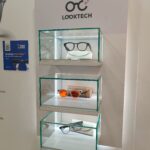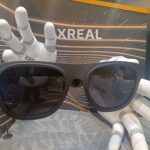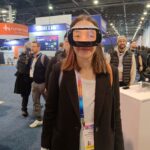CES2025, at first, looked like any other year: with around 140,000 people wandering around the 4,500 exhibitors split around different (remote) places, making this event a real unprepared marathon for most visitors! Whilst at the same time “an inspiring place to explore the latest trends that are shaping the future of tech”.
But for people like me, it was more like a Christmas market. There were smartglasses all over the place! All kind of glasses with or without screens, with different levels of specifications, but finally all “smart” in different ways.
The perception is that Meta & Essilor Luxottica have paved the way with its second generation of Ray-Ban Meta and its noticeable sales volumes. Plus within a few months many companies have positioned themselves on this market.
Other companies have come up with more specified products, with or without screens, with or without Augmented Reality (AR)….
The challenge is now to try to benchmark them and understand them. I’ve tried to provide some kind of categorisation. It is my personal opinion and subject to caution, but at least it gives some clarity and shows the products latest trends at CES2025.
Photochromic glasses
Probably the least “smart” glasses, but it was still interesting to see that quite a few brands now are creating these “colour changing” lenses. They may they be changed automatically, manually or both. Probably the most advanced in the area is Chamelo, whose lenses can be highly customised. Not only do they simple have a darker lens to protect your eyes from the sunshine, you can also have colour variations (pink, blue…) to fit your daily outfits! They have even released a “music” range with integrated speakers available on certain sport models.
“Audio” glasses
Although I don’t think the category’s name is proper, it is still true that a few products/solutions now exist by simply integrating speakers, aimed at the hearing-impaired market. Nuance from Essilor-Luxottica is one of the most popular products, in a very sleek form factor and uses your smartphone. There are quite a few companies positioning themselves in the same sector, “amplifying audio” so that you can properly hear the people around you.
However still targeting hearing impairment market, some other companies have taken the bold approach by displaying the transcription directly onto the glasses’ screen. XanderGlasses presented at CES2025 a standalone solution based on a Vuzix product, which works both offline and online. Given that the World Health Organization predicts that nearly 2.5 billion people worldwide will experience some degree of hearing loss by 2050, we can expect many companies to come up with basic efficient solutions.
“AI” glasses (no display)
This is probably the largest category of products that was unveiled at CES2025! The main reasons are that Ray-Ban Meta opened the door and proved the existence of a potential market. The basic specifications are often the same and quite straight forward to implement (speakers, microphone, CPU, Bluetooth) and that there is no display/screen (the most challenging part). Therefore, any manufacturer could easily come up with a product with an acceptable form factor.
Promoted usages fit in a nutshell: calls, translations, teleprompters, navigation for the most important one and with the use of the camera, besides taking pictures and videos, the glasses are given the ability to analyse with AI, the surroundings and provide related information (for example “where am I?”, “what I am looking at?”). However, these advanced functionalities are not currently available for consumers in Europe.
Again, many brands were featuring their new devices, and I cannot quote them all, but what I found interesting is that while the technical differentiations are small in this category. The marketing approach can be pretty different: Lawk is presenting one of their product as “TikTok glasses”. Looktech is more focused on privacy with the possibility to enable or disable data sharing. As for Mustard Glasses, they are promoting the fact that they have a customizable ecosystem app and marketplace.
The development of these marketing strategies is good news, as the potential customers will have to make some enlightened choices among a soon to be overcrowded products offering. Once again, as there is no screen, any company can eventually launch a product pretty easily, and it was visible at CES2025..
Therefore, at this stage, I would definitely suggest to a company that wants to develop their own branded glasses to rely on existing reference designs, as there is now a sufficient range of options to fit all requirements (with or without displays).
“AI” glasses (with display)
 In this area, Halliday has really been my CES2025 favourite. Not that the product is extremely polished yet, but at least they have made a bold technological choice by having the tiny projector in the frame, projecting right into your eye. The projector can be manually adjusted right to left and/or up and down. It still looks a bit fragile at this stage. However, it provides a sharp monocolour green text, the prescription challenges are not in the way anymore, and their marketing positioning being totally invisible (and it is true).
In this area, Halliday has really been my CES2025 favourite. Not that the product is extremely polished yet, but at least they have made a bold technological choice by having the tiny projector in the frame, projecting right into your eye. The projector can be manually adjusted right to left and/or up and down. It still looks a bit fragile at this stage. However, it provides a sharp monocolour green text, the prescription challenges are not in the way anymore, and their marketing positioning being totally invisible (and it is true).
Some historical smartglasses manufacturers have developed products to fit into this segment. They usually are glasses-like products, with a slim form factor, with AI leverage as the main specification.
Furthermore, we can witness some newcomers as well, such as ThinkAR that unveiled AiLens, with a 37g AI product.
“AR” glasses
This category will include the manufacturers offering products with full displays (not simple heads-up displays) and higher specifications.
Some may just be secondary displays and not really “AR” but at least they provide a lot of specifications like minimum 3DoF and nice FOV, enhanced connectivity. Form factor may be less “normal glass like” as more features are embedded, but it is getting better and better.
If some include AI in their specs, for these models, this is somehow just one feature among others (or sometimes it feels like a ‘must have’ to surf on the buzz).
In this category, we have quite a few players now. This is very encouraging for the near future, as a proper display technology is quite challenging to achieve, for example FOV, image quality & clarity, panel size….
RayNeo is a nice player in the area, and was presenting a few new products such as XR3Pro, binocular, full-colour micro-LED optical waveguide AR glasses, quite compact and with AI integration (MSRP and launch date TBC) on the TCL stand.
Rokid is a key actor as well, showing off their Rokid AR glasses for real-time GPS navigation, high-definition video calls, internet access, video games, social networks… The wearer can interact with immersive work or in a leisure environment. What set them apart though, is that they have not only integrated the first intelligent adaptation of the pupil gap but also the correction of myopia (up to -6.00 D).
Whereas the most impressive was probably XREAL with his latest release Xreal One and One Pro. They feature XREAL’s first silicon chip called X1, a fully redesigned optical engine, enhanced audio output with Sound by Bose, and a modular (!) multimodal AI camera. The image quality is crisp and clear with no blurry edges. The new optical design is slimmer. For the One Pro the FOV of 57° could be achieved with a total weight of only 87g!
Other brands have started to release some products in this area, maybe not fully refined at this stage, but quite promising like for the Mirza from NTTQonoq.
We always have a series of more vertical products, often using existing reference design but with additional hardware components and in house software to address the current needs from some verticals such as Thermal Glass for fire fighters, oil & gas or the army.
So, apart from glasses?
XR overall w as very well present through the VR headsets stands & suites (Meta, Pimax, DPVR, Goovis), but as well the XYN from Sony revealed at Siemens’ Keynote last
as very well present through the VR headsets stands & suites (Meta, Pimax, DPVR, Goovis), but as well the XYN from Sony revealed at Siemens’ Keynote last
year at CES, who Sony partnered with to develop this project. The product and related software have not been released yet but the second product iteration, meant to collaborate with engineers, architects and content creators in general, is promising.
Another interesting trend is the willingness of certain actors to find alternative ways of watching stereoscopic images without the need for a headset. Looking Glass proposes 3D frames in different sizes, and a software suite that turns any existing content into 3D content through intuitive tools. Brelyon’s UltraReality solution uses multi-focal monitors that can generate and augment information overlayed at different depths and in real-time. We can foresee how these applications will have an impact in sectors such as the automotive industry.
Haptic systems remain constantly present at CES2025, whether it be gloves, rings, or full suits as the solution offered by the Korean company IPOP with

their multi sensors patented solution “Emotense”, for fire fighters and other safety trainings.
The other interesting trend is now the growing industry around platforms used to enhance the interaction with wearables like the Finnish Double Point, or BCI mudra-band, showing the maturity of the XR materials market.
To finish on a quite funny (in my opinion) note, EyeBliss by UltraReality, introduced an “enhanced user interaction solution through advanced gaze and blink tracking . This is a solution very close to Apple Vision Pro’s EyeSight, a feature that has not been well-received by Apple customers. Since having tried it at CES2025, I kind of understand why when you look at my picture!
To conclude,
regarding CES 2025, although it was my 7th participation at the event, I have never felt the smartglasses market to be as thrilling as it is this year. The large product range covers many markets and use cases, mainly for consumers. The manufacturers are being driven by the large volume expectations, created within a few months for a very competitive landscape on the lower specifications segment. Current AR products offering is still weak against market demand, especially in the professional/industrial sector. Even though it seems that some (smaller) companies are showing real intentions to introduce products in the short term. It remains that this new boom is encouraging and will most probably lead the way to enhanced products in the coming months and years.
But perhaps most importantly I was able to witness something I have not fully embraced so far: XR has reached a new milestone and maturity. Many stands were indeed using VR headsets or immersive projection to demonstrate their solutions or innovations. This was happening in whatever their sectors or industries were, such as with the unexpected “Mixed Reality Makeup solution” by the Japanese Kosé Corporation. Smartglasses were used on the event floor as secondary displays, even Delta (awesome) Keynote at the Sphere demonstrated the partnership with Airbus, showing users with VR headsets, and all CES2025 marketing imagery featured smartglasses or VR headsets!
XR is maybe not making as much a buzz as much as AI is, but I definitely know now that this is the new normal, and it’s here to stay.
